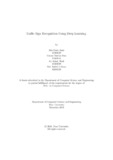| dc.contributor.advisor | Uddin, Dr. Jia | |
| dc.contributor.author | Amir, Afia Binte | |
| dc.contributor.author | Nisa, Umme Habiba | |
| dc.contributor.author | Shafi, Ali Ashab | |
| dc.contributor.author | Reza, Md. Rafid-Ur | |
| dc.date.accessioned | 2020-10-14T04:03:26Z | |
| dc.date.available | 2020-10-14T04:03:26Z | |
| dc.date.copyright | 2019 | |
| dc.date.issued | 2019-12 | |
| dc.identifier.other | ID: 15301039 | |
| dc.identifier.other | ID: 15301044 | |
| dc.identifier.other | ID: 15301099 | |
| dc.identifier.other | ID: 16101229 | |
| dc.identifier.uri | http://hdl.handle.net/10361/14058 | |
| dc.description | This thesis is submitted in partial fulfillment of the requirements for the degree of Bachelor of Science in Computer Science, 2019. | en_US |
| dc.description | Cataloged from PDF version of thesis. | |
| dc.description | Includes bibliographical references (pages 32-34). | |
| dc.description.abstract | Traffic sign recognition plays a significant role in modern automated driver assisting
systems and showing information about safety measures. It is a technology that
allows users to recognize traffic signs in real-time, typically in videos, or sometimes
just in photos. Poor identification of traffic signs cause road accidents. Moreover
In adverse situation like heavy rain,foggy weather or sleepy driver can misidentify a
traffic sign that may cause the death of hundreds of people. As a result identification
of traffic signs properly has become an obligatory topic for research. In this research,
we have used convolutional neural network for detecting and classifying the road
signs accurately. We have proposed five Keras models of CNN and compared their
results. The main challenge of this research is dealing with noise in images such as
ads, parked vehicles, pedestrians, and other moving objects or background objects
that made the recognition much more difficult. Not only the objects but also various
environmental issues like the reflection of light, rainfall, fog etc has affected the
research. In order to conduct this research we have collected our own data-set. We
roamed around Dhaka city and clicked pictures of the traffic signs as there is no
benchmark data-set available in the perspective of Bangladesh. For 500 images this
model gives out an accuracy of 63%. There have been many researches in this field
but our one is unique as it is tested on our own collected data-set on Bangladesh’s
perspective. Recognizing traffic signs has become a part of our daily essentials as
road safety depends on it, on a large scale which made it an obligatory topic for
research. | en_US |
| dc.description.statementofresponsibility | Afia Binte Amir | |
| dc.description.statementofresponsibility | Umme Habiba Nisa | |
| dc.description.statementofresponsibility | Ali Ashab Shafi | |
| dc.description.statementofresponsibility | Md. Rafid-Ur-Reza | |
| dc.format.extent | 34 pages | |
| dc.language.iso | en_US | en_US |
| dc.publisher | Brac University | en_US |
| dc.rights | Brac University theses are protected by copyright. They may be viewed from this source for any purpose, but reproduction or distribution in any format is prohibited without written permission. | |
| dc.subject | Traffic Sign | en_US |
| dc.subject | Recognition | en_US |
| dc.subject | Deep Learning | en_US |
| dc.title | Traffic sign recognition using deep learning | en_US |
| dc.type | Thesis | en_US |
| dc.contributor.department | Department of Computer Science and Engineering, Brac University | |
| dc.description.degree | B. Computer Science | |

